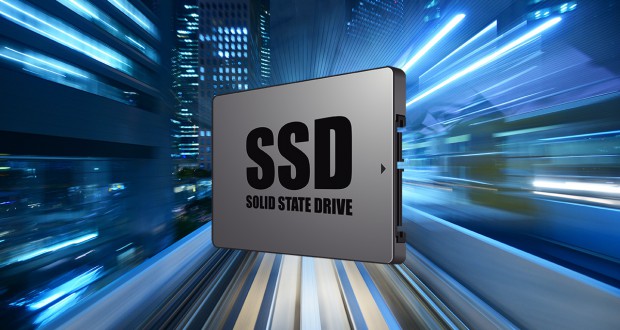Over the years there have been many advancements in the field of technology. Computer technology has progressed a lot and as a result smartphones have become more powerful compared to desktops of early 2000s. Once piece of hardware which remained the standard for a long period of time is the hard drive. It was first developed in 1950s and since 1990s the technology has remained the same. Finally a new technology has given a boost to the storage industry in the form of Solid State Drives.
Difference between hard drives and solid state drives
Traditional hard drives feature a mechanical design which means there are moving parts inside the enclosure. A hard drive consists of a platter, actuator, spindle, actuator arm and a SATA connector. The data is stored on the platter which consists of disks using the actuator. Hard drives come in 3.5-inch and 2.5-inch sizes for desktops and laptops. A traditional hard drive consumes around 6-7 watts of power and costs less than a SSD. A hard drive also produces more heat and noise compared to a SSD. Hard drives weigh approximately 752 grams.
Solid State drives utilize a non-mechanical design that consists of NAND Flash chips mounted on a circuit board. Each manufacturer designs its own SSD controller that provides different features and performance. The NAND Flash chips are extremely fast and since there are no moving parts in a SSD there is less risk of damage if dropped. SSDs come in mSATA, mPCIe, PCIe and 2.5-inch form factors for various devices. SSDs consume 3 watts of power providing better battery time and they have also a longer useful life compared to HDDs. SSDs weigh less than 100 grams making them much lighter than HDDs and ideal for laptop use. It is common for hard drives to lose data due to magnetic interferences but SSDs are secure in this regard as well.
Solid State Drive vs Hard Drive Performance
On average a SSD is 10 times faster compared to a traditional hard drive. The fastest mechanical 3.5-inch hard drive can deliver up to 130 MB/s write speed but the performance is affected by a range of things. A traditional hard drive’s speed ranges from 50 MB/s to 130 MB/s where as a SSD provides 10 times more speed.
In terms of performance, SSDs performance vary a lot depending on the form factor. A traditional 2.5-inch SSD delivers 200-550 MB/s write speed while a PCIe SSD can deliver more than 1 GB/s write speeds. This is mainly due to the limitation of SATA III connector and since PCIe lanes have a faster data transfer rate, manufacturers utilize it to develop ultra-fast SSDs.
A SSD can maximize the potential of SATA III port while hard drives only utilize 5-10% of its designated speed. Since SSDs are amazingly fast, they have become the ideal solution as OS drives. A mechanical hard drive with a fresh install of windows takes up to 40 secs to load to desktop while a SSD can boot-up your system in less than 10 seconds. As a result most people use SSDs for operating systems and softwares.
Solid state drives are also useful for video editors and graphics designers who render large files. On average a software will load 50 times much quicker on a SSD compared to a hard drive. For example, Adobe Photoshop loading time on a hard drive is around 20 secs while the program opens in less than 5 seconds on a SSD. Apart from loading, during render SSDs provide much better performance compared to hard drives. Users experience lags and stutter during active rendering when utilizing hard drives that wastes valuable time but SSDs offer a much smoother experience thus increasing work efficiency.
Gamers also take advantage of solid state drives because over the years game loading times have increased due to high resolution textures. In some games such as Max Payne 3 and Grand Theft Auto V, it takes up to 2-3 minutes to load the game on a hard drive but with a SSD users have experience this time reduced to less than a minute.
As we have already mentioned, SSDs have sequential read and write speeds up to 550 MB/s which can result in faster data transfer from one location to another. Users can transfer large amount of data in relatively quick time compared to hard drives.
In terms of videos and large files, users can open multiple files together on a SSD without sacrificing performance of the whole system where as a traditional hard drive hangs and freeze if more than one large file is opened at the same time. This effects the overall system performance and users find it extremely hard to multitask.
Lastly, SSDs have a much lower Random Read Latency compared to hard drives. A hard drive usually has 6-7 ms latency while a SSD features less than 1 ms latency improving the overall performance of the system.
Price and Capacity
The main advantage hard drives have over SSDs is the capacity and price. A traditional hard drive can store more than 6 TB of data while the maximum capacity of a SSD is 4 TB. 4 TB SSDs are very rare and expensive, most common capacity for a SSD ranges from 128 GB to 1 TB.
In terms of price, a hard drive roughly costs $0.05 per gigabyte while a SSD costs $0.20 per gigabyte. SSDs are getting popular and cheaper each day but at the moment hard drives are the most economical storage drives. A 1TB GB SATA hard drive costs $50 while a 1TB GB SSD costs around $300-$350. This is the only major disadvantage of a SSD right now but with the performance improvements it offers, it is becoming the standard drive now. Due to the price of a SSD, users utilize it for OS and applications while use hard drive as data storage.
Benchmark Your PC FREE with HARDiNFO
Here are a few recommended high-performance SSDs
 Ultimate Systems Blog
Ultimate Systems Blog




One comment
Pingback: DDR3 and DDR4 RAM Differences – Ultimate Systems blog